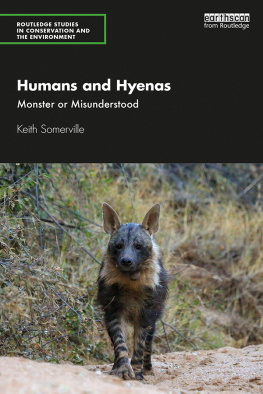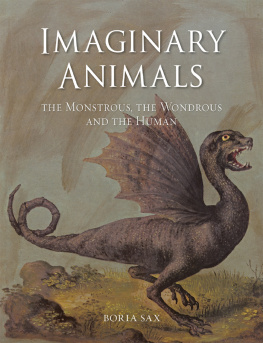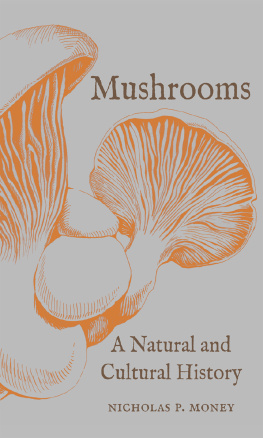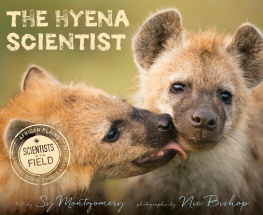No part of this publication may be reproduced, stored in a retrieval system or transmitted, in any form or by any means, electronic, mechanical, photocopying, recording or otherwise without the prior permission of the publishers.
Hyena. (Animal)
1. Hyenas
I. Title II. Title
Introduction
The hyena, hermaphroditic self-eating devourer of the dead, trailer of calving cows, ham-stringer, potential biter-off of your face at night while you slept, sad yowler, camp-follower, stinking, foul, with jaws that crack the bones the lion leaves, belly dragging, loping away on the brown plain, looking back, mongrel dog-smart in the face.
Ernest Hemingway, Green Hills of Africa, 1935
According to a keeper at the San Diego Zoo, people often approach the striped hyena and, not knowing what kind of creature it is, comment on the animals beauty. But as soon as they learn that the animal in front of them is a hyena, they become critical and negative in their comments, and quickly lose interest. our feelings about it? In the case of the hyena, so ingrained is the animals reputation that, upon learning its name, the creature itself is transformed before our very eyes.
I first started thinking seriously about hyenas in 1992, after seeing a 40-second British Public Information Film about the dangers of car crime. In this short film, a pack of striped hyenas runs up a dark alley laughing creepily and knocking over dustbins. They enter a public car park, swarm around a car and climb on top of it. One of them sticks his head and neck through the window and somehow manages to open the door. The hyenas then go on a wild rampage, invading the car, tearing out the stereo and ripping the upholstery. Finally, they run back down the alley, laughing at the mess theyve made. Today in Britain, intones a serious male voice,
theres a type of scavenger. Like a hyena, it preys on the defenceless. It shows no compassion towards its victims. Most car crimes are committed by opportunists. If your car hasnt got adequate security, youre making it easier for them. Leave it unlocked, and theyre laughing.
The final image was a road sign depicting a hyena with a red line through it, and the words: CRIME together well crack it.
This short film appeared regularly on British television in 1992, and I was oddly taken by it. I admired how the hyenas ran down the alley, like hooligans on a rampage. I was impressed by the way they tore into the sleek, expensive vehicle, pulling it apart with their teeth, strewing the contents of some middle managers briefcase all over the ground. I was all in favour of this gleeful assault on the symbols of executive privilege. To put it bluntly, I was on their side. Yet, I was in the minority. Apparently, the film was unusually successful in combating car theft, particularly when coupled with the nationwide police initiative targeting car criminals known as Operation Hyena.
At the time, I did not know enough about hyenas to understand how this short propaganda film exploited their public image as criminals and thieves. The voiceover described the hyena as a type of scavenger that preys on the defenceless, but, as I have since discovered, not all hyenas are scavengers, and what is more, scavengers do not prey on the defenceless, they eat corpses and carrion. To make matters worse, the hyenas shown in the film run together in a pack, laughing and yet these are striped hyenas, which are not pack animals and do not laugh. In fact, striped hyenas are cautious, gentle creatures that generally live alone or in pairs.
I have since learned that this public information film is typical in its presentation of hyenas as filthy, snickering tricksterslurking in the back alleyways of the animal kingdom. Indeed, throughout history, these fascinating and unusual creatures have been scorned, demonized, reviled, mistreated and misunderstood, miscast as scapegoats, scavengers, vandals and thieves. More often than not, this unloved animal becomes a projection of the observer, representing whatever kind of Otherness is felt to be most frightening. In other words, our hyenas are ourselves.
Those familiar with real hyenas more closely to cat than dog, with a touch of the ferret thrown in for bad luck. There is a sublime and hideous grandeur to this big-eared, red-eyed, corpse-eating creature that has rarely been recognized or acknowledged. In this book, I would like to introduce you formerly and properly to the hyena. I hope you will meet a new friend.
Evolution and Distribution
In one fantastic form or another, the creature we now call the hyena has been around for more than 26 million years. Its earliest ancestor was a small, nimble, tree-dwelling mammal resembling a streamlined badger, with short, dense fur and a striped or spotted pelt. Over millions of years, these agile creatures adapted to their environment by increasing in size, growing longer legs and coming down from the trees, finally evolving into dog-sized carnivores. Fifteen million years ago, over 30 different species of these proto-hyenas roamed unchallenged through Europe and Asia. Their reign came to an end between five and seven million years ago, when lowered sea levels exposed the Baring Land Bridge. Consequently, large numbers of other canids including wolves, foxes, jackals and coyotes crossed overland from North America to Europe and Asia, vastly outnumbering the hyenas and wiping out their food supplies. Only two types of hyena survived: one that adapted by eating insects, and a second that developed bone-crushing teeth. These are the ancestors of the hyenas that live among us today.














